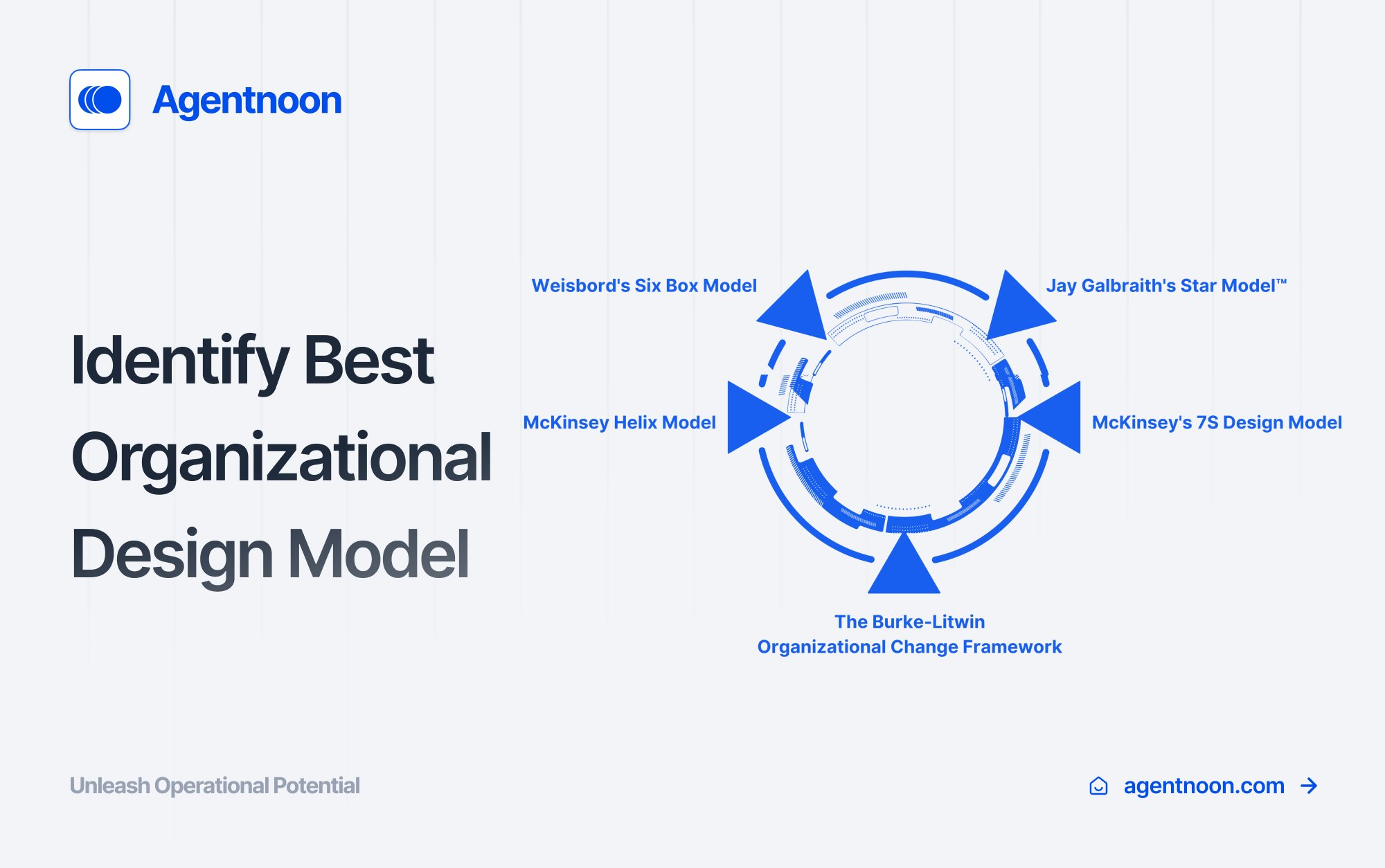Comprehensive Guide to Skills Gap Analysis: Identify and Bridge Gaps
Discover actionable strategies for conducting a Skills Gap Analysis to identify and bridge skill gaps in your organization through Agentnoon's guide
Explore the best organizational design models with Agentnoon's guide on top org models. From structure theories to McKinsey models, boost your HR strategy.

Organizational design models are essential for understanding and improving the efficiency of businesses. These models provide a framework for structuring an organization's operations, processes, and resources. Read about Organizational Design guide here.
This blog offers an ultimate overview of 5 popular organizational design models, along with their pros and cons.
These 5 org models are categorized as:
Diagnostic: Jay Galbraith's Star Model™, McKinsey's 7S Design Model, Weisbord's Six Box Model
Transformation: The Burke-Litwin Organizational Change Framework
Experimental: McKinsey Helix Model
Understanding these five different organizational models will help you make informed decisions. As a HR leader, you will be able to choose the right model for your company's success by the end of this blog.
Diagnostic models involve evaluating an organization's current performance using evidence-based methods. The goal is to find opportunities for improvement through a collaborative process.
This process aims to identify the root cause of issues and develop interventions for planned or unexpected changes. Businesses can use diagnostic models to improve their efficiency, productivity, and overall performance.
The Star Model™ framework, developed by Jay Galbraith, is a model that strives to establish a harmonious relationship between five fundamental components: strategy, structure, processes, rewards, and people.
The primary goal of this model is to achieve organizational effectiveness. This model ensures that these five components are seamlessly integrated and in sync with one another.
Strategy: outlines organizational goals, objectives, values, and missions. It allows strategists to prioritize activities effectively.
Structure: involves organizing the company into departments responsible for specific tasks and objectives. It determines reporting relationships, the flow of communication, and decision-making processes.
Processes: the procedures, systems, and protocols in place to ensure that tasks are completed efficiently and effectively. This component encompasses the workflows and communication channels. Further enabling individuals and teams to collaborate and coordinate their efforts.
Rewards: involve designing a compensation and recognition system that aligns with the company's goals and objectives.
People: refers to the management of the workforce, including hiring, training, retaining, and developing employees, as well as fostering teamwork and motivation through a positive work culture.
Pros:
Cons:
The McKinsey 7S Design Model is a strategic management tool used to evaluate and improve the performance of an organization. It consists of seven interdependent elements that together make up the organization's success:
The 7S Model highlights the interdependency between these elements and demonstrates how they impact organizational performance. For example, if the organization has a clear strategy but a weak structure, it will be difficult to implement that strategy effectively. Similarly, if the organization has skilled employees but a poor culture, it may struggle to retain those employees.
Pros:
Cons:
Weisbord's Six Box Model is a diagnostic framework that assesses organizational effectiveness by analyzing six critical factors:
Weisbord's Six Box Model helps diagnose organizational problems by highlighting areas that need improvement and providing a framework for change. The model allows business leaders to identify the root cause of the situation by analyzing each of those factors. It then suggests ways to improve the organization.
Pros:
Cons:
Transformation models are designed to help companies shift their focus from traditional hierarchical structures to more flexible and adaptable ones better suited to today's fast-paced business environment.
This model can support leaders in identifying and addressing critical issues that can hinder organizational growth. It prioritizes the human aspect of organizational performance.
The Burke-Litwin Organizational Change Framework is a comprehensive model for driving change within an organization. The model has 12 key dimensions, including the external environment, mission and strategy, leadership, and individual and organizational performance.
This organizational design model is more comprehensive than most frameworks. It categorizes those twelve key dimensions into five groups, each influenced by the one above and below it.
Developing targeted and effective change strategies is crucial in achieving long-lasting and sustainable change. The Burke-Litwin framework offers a comprehensive approach to help organizations address leadership, culture, strategy, or structure challenges, leading to positive change and success. This framework can be powerful in driving change by utilizing cause-and-effect relationships.
Pros:
Cons:
Experimental models in organizational design are the innovative and untested approaches companies use to structure their operations.
This model is developed to address specific challenges or opportunities that traditional organizational structures cannot accommodate.
In 2020, McKinsey found that modern matrix and agility models were causing businesses to become complicated, slow, and inflexible. In order to address this issue, they created the helix organizational model, named after the double helix structure of a DNA molecule. This model involves establishing two separate, parallel lines of accountability that are equal and interconnected yet distinct.
The framework comprises five building blocks essential for organizations looking to improve their agility and adaptability in an ever-changing business environment.
Pros:
Cons:
Organizational design models can help businesses in several ways. Businesses can better understand their strengths and weaknesses and pinpoint areas for improvement. This helps companies optimize their operations and processes, increasing productivity, profitability, and competitiveness.
This blog post covers five popular organizational design models and their advantages and disadvantages. Understanding these models will help business leaders make informed decisions and choose the right one for their company's success.
Schedule a demo call to discover how Agentnoon can assist you in visualizing your people data and growing an effective organization that aligns with your business objectives!
Discover actionable strategies for conducting a Skills Gap Analysis to identify and bridge skill gaps in your organization through Agentnoon's guide
Create an interactive org chart with Agentnoon's organizational chart software. Simplify team structuring and planning with real-time org...
Explore the fundamentals of operating models in our detailed guide. See how strategic alignment, process efficiency & innovative structures drive...